
by Mark Tancig | Mar 6, 2019
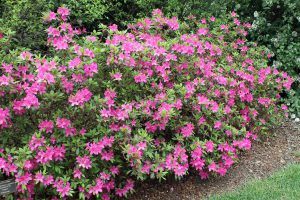
Azaleas are a beautiful shrub for the north Florida landscape, especially if pruned properly. Source: Larry Williams, UF/IFAS
The sight of azaleas in the north Florida spring just makes you feel good. They are so vibrant, and with such variation, that you can’t take your eyes off them. As an appreciator of these beautiful displays of color, nothing pains me more than to see an improperly pruned azalea during this time. If you must prune your azaleas, please, please only prune them once a year and only soon after flowering has ended! This public service announcement will hopefully ensure we all get to see the full azalea show. Otherwise, we’ll be left with mostly green hedges, some flowers uncomfortably tucked in the interior of the plants, or flowers poking out the sides like a middle-aged man’s balding head.
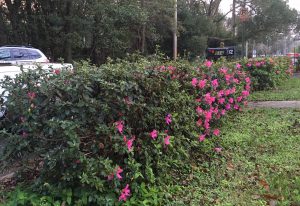
If pruned properly and at the right time, this azalea shrub would be a mass of flowers. Source: Mark Tancig, UF/IFAS.
The common flowering azaleas in landscaped settings are native to Japan and a relative of blueberries. They comprise many different hybrids, cultivars, and varieties of plants in the genus Rhododendron (Greek for rose-tree) and have been cultivated for centuries. Long ago, I’m sure, those who studied plants and tinkered with azaleas realized that their vegetative growth (new leaves and stems) ends soon after flower bud initiation. This means that later prunings, or multiple prunings throughout the year, will be taking off more developing flower buds than new leaf and stem growth.
To prevent depriving us all of less flowers, consider why – or if – they need pruning in the first place. Proper planning and planting can prevent azaleas, which naturally want to be a sprawling shrub, from growing into the sidewalk or driveway. If you’ve inherited azaleas that may be the right plant, but slightly in the wrong place, they can be heavily pruned every couple of years to keep them in check, and can even be transplanted. Azaleas are not a good choice for formal hedges. If given the right place and enough space, the only required pruning would be dead, diseased, or crossing branches.
If you decide you need to prune – whether to knock back for space or for general shape – only bust out the loppers once the flowers have withered on the ground… and then lock those loppers away so that you won’t be tempted. If you have landscapers working for you, remind them to keep the hedge trimmers away from the azaleas.
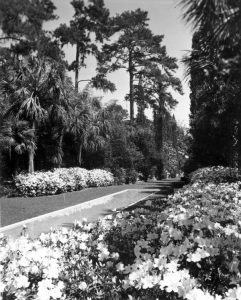
Azaleas are vibrant, even in black and white! Source: Florida State Archives, Florida Memory Project.
For the love of flowers, please prune azaleas thoughtfully, and share this information with others
P.S. We also have several species of native azaleas (including Rhododendron austrinum and Rhododendron canescens) that can be a beautiful addition to the landscape.
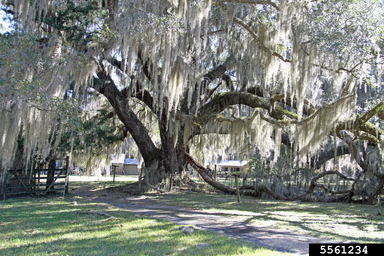
by Mark Tancig | Dec 17, 2018

Native trees, like this Live Oak (Quercus virginiana), provide habitat for various insects fed upon by birds. Source: James Holland, Bugwood.org
Planting native plants is a topic many north Florida gardeners, and subscribers to Gardening in the Panhandle, have seen covered in various ways and formats. It doesn’t take a great leap of understanding to realize that native plants are highly valued by our wildlife, which have adapted to living with these plants for millennia. However, we also get a lot of information about the latest, greatest landscape plant variety, many of which are non-native, and are lured to purchase them by their beautiful flowers and/or foliage. In the wake of Hurricane Michael, the importance of selecting native plants for the landscape becomes apparent when you look around and see whole forests severely disturbed. Furthermore, recent research has shown how much our native wildlife prefer native plants and need them for the best chances of survival.
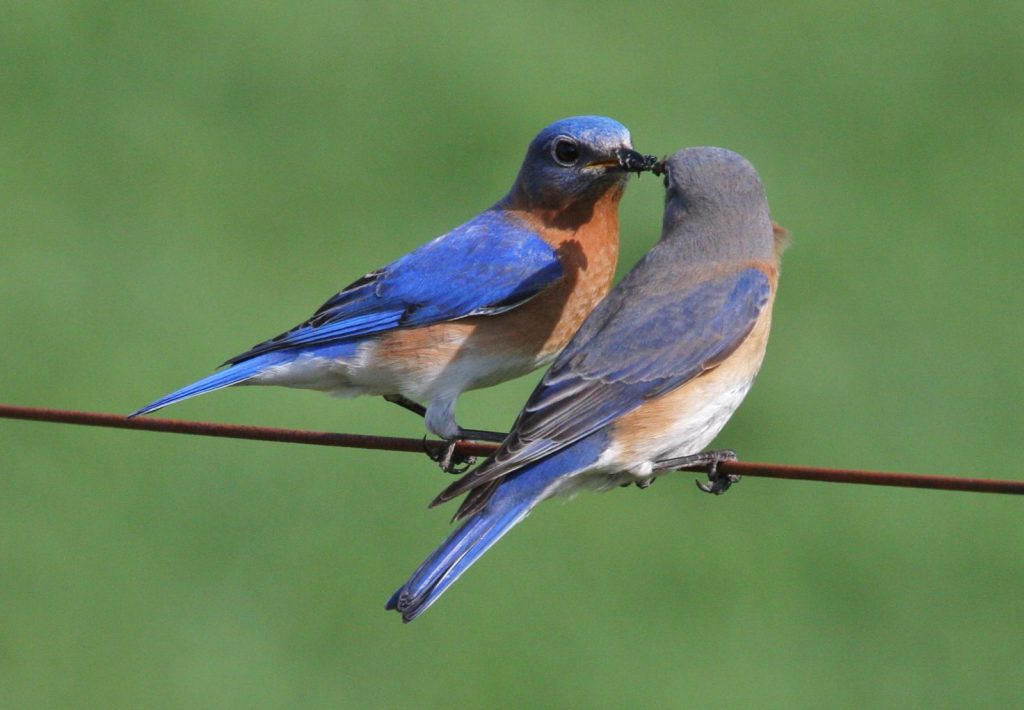
Eastern bluebirds are an example of a bird that relies on insects. Source: Sandysphotos, Creative Commons.
Why Native Plants?
It’s not that non-native ornamental plants are “bad”, unless they’re the terrible invasive, exotic species like kudzu, Chine privet, etc., it’s just that the food chains that support our wildlife are adapted to native plants. A recent report published in the National Proceedings of Science found that chickadees had far better success fledging young when they foraged landscape areas containing 70% or more native plant cover. The reason for their success was that the insects they feed on utilize native species more than non-native plant species. Does that mean non-natives provide no value? Not necessarily. Non-native ornamental plants can be important sources of nectar and pollen and, as you know from experience dealing with pest problems on non-native plants, they also support insects. Native plants just support more of an abundance of these insects.
Following a large disturbance like Hurricane Michael, many insects, birds, and other wildlife will likely see a decrease in numbers and/or reproductive success due to the loss and/or disruption of native plant ecosystems. As stated in the recent report, restoration of urban areas should prioritize native plants to support local food webs.
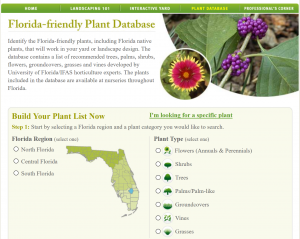
The deactivated_site website is a great resource to find native trees for your area. Source: Screenshot, deactivated_site.
The deactivated_site website is an easy way to start putting together a list of potential plants. The website’s Florida-Friendly Plant Database allows users to select the area of Florida they live in, site conditions, plant type (tree, shrub, etc.), and to specify native plants only. It then searches the database for plants that meet those conditions and creates a list of species, along with photos and care information. If you’re thinking about how these trees hold up to storms, you can cross-check that list with UF/IFAS’s Wind and Trees EDIS publication. Of course, if you have any questions along the way, please contact your local UF/IFAS Extension Office.
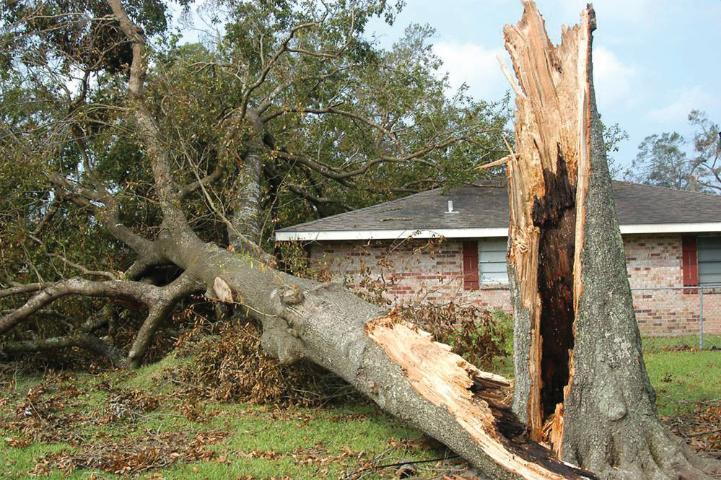
by Mark Tancig | Nov 8, 2018
Trees have a pretty bad reputation in north Florida these days. They’re on our homes, cars, streets, power lines, and all over the yard causing a lot of grief. While my heart goes out to all of those dealing with trees in places they shouldn’t be, now’s a good time to remember all the reasons we should want trees around. It’s also a good time to review how to minimize tree impacts from future storms.
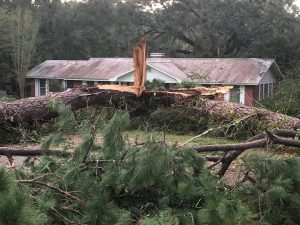
An older, poorly branched loblolly pine in Tallahassee. Credit: Mark Tancig
Benefits of Trees
Beyond being a huge source of oxygen, necessary for many organisms to live, trees provide other benefits such as well. According to a recent analysis of Tallahassee’s urban trees, approximately three million pounds of pollutants, such as carbon monoxide, nitrogen dioxide, ozone, sulfur dioxide, and particulate matter, are reportedly removed each year. The same report calculated that half a billion gallons of precipitation was intercepted by these trees rather than becoming stormwater runoff, reducing impacts of erosion and non-point source pollution. These trees also saved citizens an estimated one million dollars. Total annual benefits to the citizens was over $15 million per year! Researchers have found that trees increase residential or commercial property values an average of 7%!
Ways to Minimize Tree Failure
Select Replacement Trees Wisely
While very few trees could make it through sustained winds of 155 mph, replanting trees sooner will help communities see the benefits mentioned above and help them return to their former beauty. Even the most wind-resistant trees are likely to fail in a storm like Hurricane Michael. UF/IFAS researchers have studied wind-thrown trees following hurricanes and have found these trees to be some of the most wind-resistant – hollies (Ilex spp.), southern magnolia (Magnolia grandiflora), live oak (Quercus virginiana), cypress (Taxodium spp.), cabbage palm (Sabal palmetto), and, interestingly, sparkleberry (Vaccinium arboreum).
The least wind-resistant trees include pecan (Carya illinoiensis), tulip poplar (Liriodendron tulipifera), laurelcherry (Prunus caroliniana), laurel oak (Quercus laurifolia), water oak (Quercus nigra), southern red oak (Quercus falcata), red cedar (Juniperus virginiana), pines (Pinus spp.), and Chinese elm (Ulmus parvifolia).
When replanting, consider planting at least three trees in a group rather than an individual tree, as researchers found that trees in groups fared better.
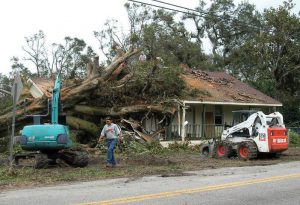
An older water or laurel oak. Credit: UF/IFAS.
Tree Care
With existing trees and newly planted trees, taking good care of the tree can help it withstand high winds. In addition to proper pruning techniques and providing adequate root zone space, paying close attention to minimize soil compaction and root zone disturbances will help create a stronger root system. Older trees should be regularly monitored for potential signs of decay.
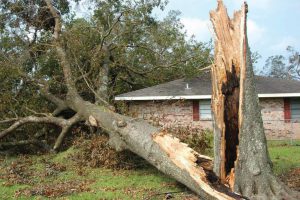
An older oak with decay in trunk. Credit: UF/IFAS.
UF/IFAS has many great resources related to tree health and recovery after hurricanes. A search for Urban Forest Hurricane Recovery Program at our EDIS website (https://edis.ifas.ufl.edu) has several publications to help decide how to move forward and create a healthy urban forest. Let’s not allow our frustration with the tree on the roof to prevent us from recognizing that trees are good.
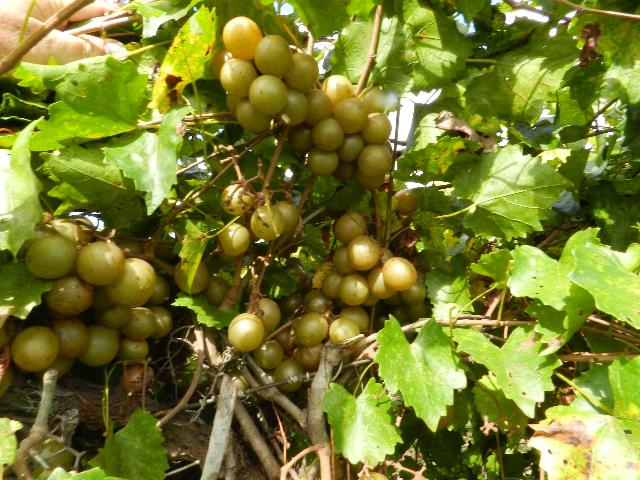
by Mark Tancig | Sep 6, 2018
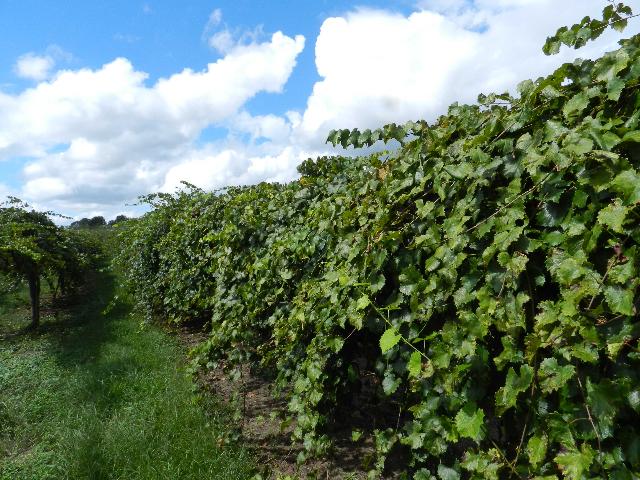
A grape vineyard. Credit: Peter Andersen, UF/IFAS.
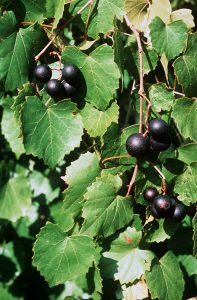
The classic muscadine (Vitis rotundifolia). Credit: Carl Hunter. USDA-PLANTS Database.
This is the time of year to be on the watch for purple-stained sidewalks and driveways – a sign that ripe muscadine grapes are falling from above. The muscadine grape (Vitis rotundifolia) is a native Florida vine that has been enjoyed by Native Americans, colonists, and contemporary Floridians alike. In addition to the classic muscadine and scuppernong, a light-colored variety of muscadine, there are five other native species of grape (Vitis spp.) to be found growing in natural areas or along woodland edges. All are edible, however, the muscadine has the largest, tastiest fruit.
Many north Florida gardeners have some species of grape growing in their landscapes and consider it a weed due to its aggressive growth. Unfortunately, since the vines are functionally dioecious (separate male and female plants) and most wild plants are male, it is unlikely that those annoying grapevines at the garden’s edge will ever bear fruit. But every now and again, luck strikes! That’s why finding a purple-stained sidewalk or parking area is such an exciting event. I have some of these locations saved in my memory to visit this time of year, especially since all the grapevines in my own property have yet to bear one fruit! If necessary, control methods for grapevine in a landscape include repeated pruning back or the use of herbicides. Muscadines and other grapes are intolerant of shade so will eventually perish if cut back and located under a canopy of trees or shrubs.
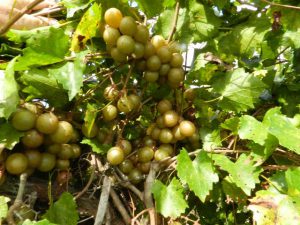
The bronze-colored scuppernong. Credit: Peter Andersen. UF/IFAS.
Good News! There are plenty of varieties bred for the backyard and commercial fruit grower. Since muscadines are native, they require little, if any, pesticides, making them a great choice for a sustainable landscape or orchard. The vines can be grown up an arbor or a complete vineyard trellis system can be built for maximum harvest. A UF/IFAS fact sheet called “The Muscadine Grape” (publication #HS763) contains all the information needed to choose the right variety, design a vineyard, and implement the best pruning, irrigation, and fertilization schedule.
Whether fresh off the vine or in jams or wine, muscadines are a sweet, summery treat for Floridians.
by Mark Tancig | Jul 11, 2018
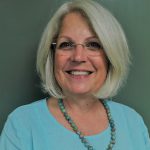 Guest Post by Leon County Family & Consumer Sciences Agent Heidi Copeland (pictured)
Guest Post by Leon County Family & Consumer Sciences Agent Heidi Copeland (pictured)
With all the rain of late, there seems to be an interest in mycology. You know, the fruiting body of fungi called mushrooms! Edible mushrooms in particular.
It is not unusual; our subtropical summer weather tends to make some fungi flourish! Moreover, apparently, there is a bumper crop of fungi this year. Phone calls to the University of Florida/IFAS Extension office about eating mushrooms has increased. Individuals have even brought mushrooms to the office inquiring if they are of the edible variety.
Our reputation as Extension Agents would certainly be damaged if we did not adhere to a few rules… always read a label, use research-based information, and NEVER tell anyone that a mushroom is edible. It is not that there are not delicious wild mushrooms out there; a recent July 2017, publication of Microbiology Spectrum estimates millions of species. However, even the scientists do not agree as only about 120,000 of them have been described, so far. Not all are edible. Some fungi are poisonous to the point of being deadly.
Matt Smith, an Assistant Professor in the Department of Plant Pathology and the curator of the UF Fungal Herbarium (FLAS) knows a lot about mycology. In fact, he is also the curator of the fungal herbarium managed by the UF Department of Plant Pathology at the Florida Museum of Natural History in Gainesville. The fungal herbarium is a valuable resource and its collections have many important aspects including information about fungi that are deadly poisonous to humans and pets when consumed.

Lion’s Mane mushroom. Credit: Robert Smith; Cabin Bluff Land Management; Bugwood.org
In addition, the UF fungal herbarium is participating in a National Science Foundation-funded project to digitize and database as many US macrofungi collections as possible. This project, the Macrofungi Collection Consortium, includes 34 institutions in 24 states. The project began in July 2012 and will aim to capture data for roughly 1.3 million fungal specimens.
With that said, there is enough scientific research out there to conclude mushroom identification is indeed difficult. Many mushrooms look similar, but are oh so different!
If you are truly interested in eating what you forage MAKE time to study, with experts! Mushrooms, particularly those you plan to eat that are not identified correctly could send you to the emergency room … or worse. The toxicity of a mushroom varies by how much has been consumed. Poisoning symptoms range from stomachaches, drowsiness and confusion, to heart, liver and kidney damage. The symptoms may occur soon after eating a mushroom or can be delayed for six to 24 hours.

Chanterelle mushroom. Credit: Chris Evans; University of Illinois; Bugwood.org
Delayed symptoms are common. Seek help immediately if you think you may have eaten a poisonous mushroom, even if there are no obvious signs of toxicity. Call the Poison Center’s 24-hour emergency hotline at 1-800-222-1222. You will receive immediate, free and confidential treatment advice from the poison experts.
And if you are determined to make foraging for food a recreational hobby or even want to learn more about what is in your Florida yard, the book Common Florida Mushrooms by University of Florida’s Institute of Food and Agricultural Sciences Emeritus Faculty Dr. James Kimbrough, identifies and describes 268 species of mushrooms found in the sunshine state.
Most importantly, teach your children to NEVER eat any mushroom picked from the ground. It is indeed better to be SAFE than sorry.
People who are interested visiting the fungal herbarium should contact:
Dr. Matthew Smith
email: trufflesmith[nospam]@ufl.edu


















